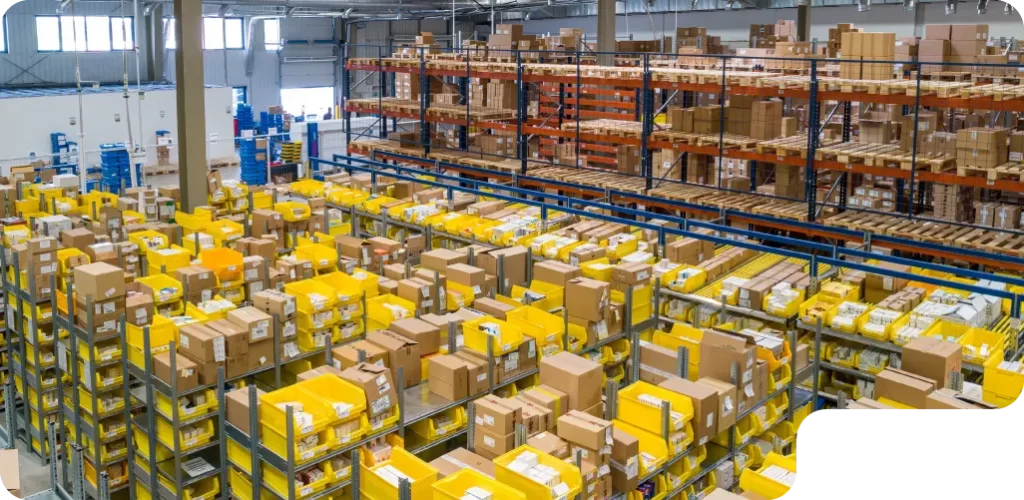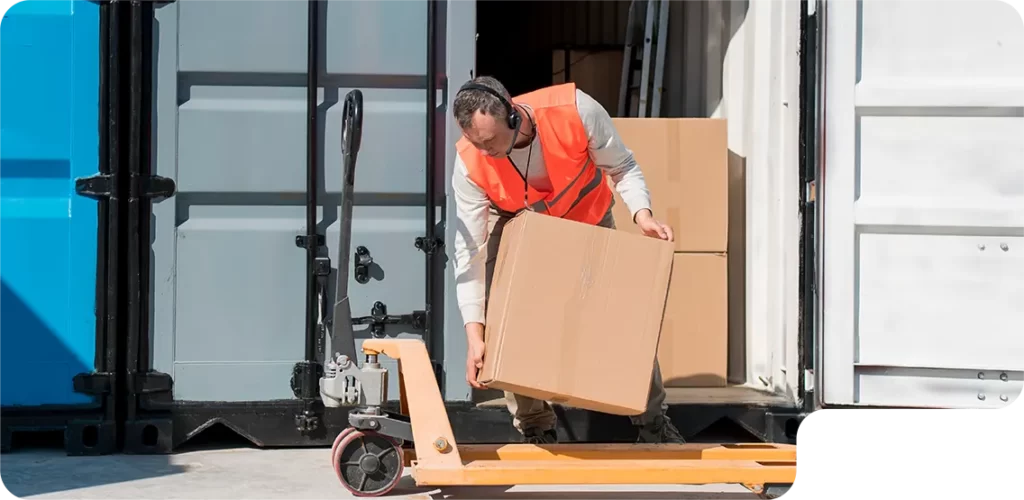Table of Contents
More Warehousing Content
Get the latest e-commerce industry news, best practices, and product updates!
Table of Contents
More Warehousing Content
Share this
Get the latest e-commerce industry news, best practices, and product updates!
Table of Contents
Share This
More Warehousing Content
Get the latest e-commerce industry news, best practices, and product updates!
Cross-docking is an integral part of the e-commerce supply chain, helping in the constant movement of products. Let us take a look at how it works.

What is Cross-Docking?
Cross-docking is a logistics method that involves distributing products from a supplier or production plant straight to an outbound transporter. Cross-docking occurs in a distribution docking station, with dock doors on both sides. It’s a strategy to ensure supply chains run efficiently. Cross-docking centers are more of a “sorting center” than a traditional distribution center, with commodities passing quickly due to limited storage space.
Cross-docking terminals have significantly less storage space than distribution centers. The docking facility is divided into inbound and outbound channels. As a result, inbound shipments are delivered to a receiving dock. The products are then transported straight to outward destinations via pallet trucks, conveyor belts, forklifts, or other means, where they are sorted and consolidated before being shipped. Typically, cargo spends fewer than 24 hours at a docking station.

What are the Differences Between Pre-Distribution and Post-Distribution Cross-Docking?
Cross-docking is categorized into two phases: pre-distribution and post-distribution.
Pre-distribution involves the unloading, sorting, and repacking of items following pre-defined distribution instructions. In other words, before the items leave the provider, the buyer is identified.
Sorting is postponed in the post-distribution phase until the appropriate facility and clients are selected, based on market demand. That is, items may stay a bit longer at the distribution center or cross-dock operations, but merchants and providers profit from the extra time to make better, more educated choices about where to send their products. They do this by relying on the point of sale trends, sales predictions, and in-store stock.

What are the Advantages of Cross-Docking?
When merchants order goods transported straight to stores by suppliers, cross-docking might be helpful. Furthermore, suppose a retailer manages inbound transit from suppliers through their carriers or fleet system and stores along the lane or route. In that case, adding a cross-dock program enables collecting supplier goods or inbound products on the return trip, reducing “empty” miles.
One of the primary benefits of cross-docking operations is that it allows for improved workflow without requiring a new cross-docking warehouse or distribution center. Because things spend almost no time in your facility, storage and handling costs decrease, and delivery is speedier.
Some of the common advantages of the cross-docking system are listed below:
- Savings on storage space occupancy: Although an area in the cross-docking warehouse must be set aside for managing and processing inbound items, cross-docking helps free up central storage space. Saving up on storage space is a cost-effective method that can help you sort out your storage preferences.
- The number of procedures and loads handled lead to reduced risks: Unloading, product checking, order preparation, and goods shipping are all preserved, but middle-stage duties like sorting and storing are no longer available. Lowered handling reduces the danger of damage to the goods by reducing their handling and travel within your cross-docking system. An additional benefit is an improvement in operational efficiency.
- It reduces delivery times and increases supply chain agility: Cross-docking saves time while shipping goods because it streamlines the traditional approach. The saved time results in better service delivery.
- Reduces the carbon footprint of a supply chain: Cross-docking affects power savings in terms of merchandise mobility both in and out of the warehouse, allowing for a more eco-friendly distribution network to operate.
- Increases customer satisfaction: Because cross-docking services eliminate the need for merchandise capability, they can be delivered to clients in a time-efficient manner. As transportation leads, times are cut, and goods are completed on time, impacting your client care.
- Reduces staff-related costs: It is challenging to run a warehouse independently. It takes many people to transport items from containers to storage. Management must also ensure that the facility is running well and that there is always enough room for incoming cargo. While cross-docking does not remove all employees from transport, it does lower the number of people needed for a fast turnover and assures that the customers’ costs and profits are met.

What are the Disadvantages of Cross-Docking?
Cross-docking models help in increasing business efficiency and delivery speed but also come with some disadvantages, such as:
- Cross-docking terminals demand a lot of work, planning and take up a lot of time to create a well-maintained management system that requires time and undivided attention.
- Cross-docking also requires a significant amount of capital as you will have to create cross-docking terminals in the warehouse.
- Some suppliers may be unable to deliver consumer goods to the cross-loading dock.
- The organization must have confidence that its suppliers will supply the suitable goods in the correct quantity to the cross-docking facility on time, leaving no room for error.
- Many transit carriers are required for the cross-docking facility to function correctly. Hence it is primarily dependent on truck-based transportation.

When is Cross-Docking Used?
While cross-docking is a fundamental process, it aids in increasing efficiency in highly complicated distribution networks. The supply chain of each firm varies in intricacy due to diverse variables, and these elements influence when and how cross-docking is used.
The four most common circumstances for cross-docking are as follows:
- The most common application of cross-docking is when the market for any particular type of inventory is consistent. These goods can be placed on a recurring fulfillment cycle by using cross-docking. Cross-docking reduces the need to hold excess goods in case of out-of-stock occurrences.
- Cross-docking is commonly employed when dealing with time-sensitive or consumable inventory. Inventory must reach merchants with an acceptable shelf life due to lower shelf life. Delivery time is minimized by avoiding storage and leveraging cross-docking. Minimized delivery time gives goods a more comprehensive sales period.
- Cross-docking can be used to quickly distribute vast quantities of varying stock regularly because buyers cannot expect a specific inventory item to be in stock. Out-of-stock circumstances are unimportant in this case; therefore, holding excess goods is unnecessary.
- Lastly, a cross-docking method is used to fill orders for customers who can wait for their orders. Consumers often assume a short delivery time for electronics and furnishings. Instead of storing these massive goods in-store or at a distribution center, merchants can quickly fulfill orders from a single site by employing cross-docking to help shorten delivery times.
What are the Different Methods of Cross-Docking?
Cross-docking refers to a logistics strategy distributing products directly from producers or distributors to consumers. This operation takes place inside a distribution docking terminal with doors for arriving and departing trucks.
Because the commodities are supposed to move quickly, this technique requires little storage space. Cross-docking acquired its name because goods are accepted at the inbound port and transferred to the outbound trucks via the dock.
Even though these elements are common to all cross-docking terminals, there are three separate versions of this approach:
Continuous Cross-Docking
The first and most basic type is continuous cross-docking. The terminal features a central location where products are transported from one vehicle to another. Most docks are in the shape of a line intended to make loading and unloading straightforward and quick.
If either the inbound or outbound trucks arrive early or late, the truck that comes first will wait for the other to appear so that the items can be transferred as fast as possible. The same products that arrive are moved in their totality to another truck.
Consolidation Cross-Docking
In many circumstances, it is necessary to combine multiple products in one area before moving them all to another. For example, if a significant retail store has bought goods, it would be inefficient to drive numerous vehicles that aren’t completely loaded.
Inefficient unloading is why consolidation cross-docking was introduced. This procedure entails combining numerous separate loads onto a single outbound truck. In this case, the terminal has more significant storage space where various goods can be loaded and retained until the outgoing truck comes.
Deconsolidation Cross-Docking
As you might expect, deconsolidation cross-docking is the polar opposite of consolidation. In this case, a sizable inbound truck comes laden with various merchandise and stops at the cross-docking terminals to dump everything onto the storage facility. Following this, the products are separately loaded into outbound trucks.
Most of these products are supplied directly to clients and must be segregated because they are part of small, individual orders. Deconsolidation cross-docking reduces handling, transportation, and transfer costs while allowing customers to receive their products faster.
Although there are several advantages, work and organizational, and financial outcomes to employing cross-docking, firms that intend to use this strategy must ensure adequate adherence, integrity, and accountability. Controlling all shipments and having sufficient visibility in terms of cross-docking is critical to working efficiently. You will feel secure knowing that all of your possessions are cared for and controlled.

Who Benefits Most from Cross-Docking?
Almost any firm benefits from a system in which cargo is handled more rapidly and waiting times are kept minimum. Still, specific sectors can benefit from cross-docking in their distribution networks.
Shorter shipment timeframes and the right to compete with big names renowned for their fast response rates through order placement to delivery in the consumer’s hands benefit retailers, consumer products, and automobile parts companies. However, chemical businesses and the food service industries benefit from a process that utilizes almost no storage space or costs and promptly transfers products from the factory to the customer.
Cross-docking is a highly cost-effective solution for any organization with high-volume exports and significant transportation needs. Shifting from the conventional distribution center model can also save money for businesses that want to enhance stock rotations and reduce the material handling process.
Types of Cross-Docking
The term “Cross-Docking” has been used to describe various activities, including the quick acquisition and movement of objects. Some of the most common types of cross-docking as listed below:
Manufacturing cross-docking
When products required by production are received, and the warehouses produce sub-assemblies for purchases.
Distributor cross-docking
The instance when inbound products are loaded into mixed goods crates for delivery to customers. Distributor cross-docking is similar to consolidation cross-docking.
Opportunistic cross-docking
This can be used in any distribution center to move an item directly from the receiving area to the transportation area to suit a specific need.
Retail cross-docking
When the merchandise arrives from various vendors and is loaded onto outbound trucks heading for multiple store outlets.
Transportation cross-docking
The instance in which the cargo from multiple carriers is bundled to achieve economic growth.

What are the Risks Associated with Cross-Docking?
Cross-docking is an essential component of logistics management. It enables businesses to transport things swiftly and effectively from one location to another while reducing storage and handling costs. By keeping products in continuous motion, cross-docking decreases the chance of damage or spoiling. However, it can come with some risks, which are as follows:
- Companies that want to use cross-docking to streamline their processes must grasp the initial costs and prerequisites for doing so successfully.
- A digitized and well-maintained logistics network, significant expenditures in automation, transparency, inbound and outbound logistics, and a sufficient transport network are all required. Proper tracking is also vital for overall function.
- There are also some hazards associated with the increased freight management and operating costs of moving and transporting the merchandise. Still, these are usually offset by cost savings related to warehouse handling and storage.

What is a Cross-Dock Warehouse?
Combining the terms warehouse and cross-dock may appear strange because cross-docking aims to eliminate the expenses, inefficiencies, and risks associated with traditional warehousing. While cross-docking is intended to reduce inventory retention, a secure, contained facility is still necessary to unload and reorganize inbound products for more effective outbound shipment.
Cross-docking stations are locations where things are processed and rearranged before being shipped to the exact location.
What are Some Examples of Cross-Docking Strategies?
Cross-docking is neither complicated nor straightforward; the process requires precision and perfect organization as it is an integral part of the supply chain. Some basic strategies in cross-docking come in handy in situations such as:
- Your truck is too heavy: A cross-dock service provider can adjust your load or discharge products to make you compliant if your truck is overweight or over-axle weighted.
- You’re sending temperature-sensitive merchandise: Many cross-docking service providers feature climate-controlled storage units (including temperature-controlled docks) and refrigerated trucks to keep your temperature-sensitive items in compliance.
- You have a trailer full of mixed freight: A trailer may be packed inefficiently, with the first pallets to be removed sitting behind subsequent pallets. In this situation, the driver can unload unneeded pallets at a cross-dock station, deliver the pallets that the driver must deliver immediately, and return to the facility to collect any remaining pallets.
Sign up today and LEAVE THE LOGISTICS TO US
Sign up, and we will get back to you within 24 hours to discuss what services would be best for your business needs. Or speak with us now and tell us what you need.
FAQs
Some of the most popular products that frequently go through cross-docking are perishable products that demand swift shipment, pre-tagged products that are ready for sale, promotional products, and staple products with constant demand. Pre-packaged, pre-picked orders from customers from a different warehouse are suited for cross-docking.
Cross-docking is the process of unloading inbound freight from one vehicle, storing it at a warehouse or terminal for a short time, and then unloading it onto a truck for outgoing transport. When arriving freight is emptied, the pallets are broken down, the contents are processed, and the pallets are re-palletized for outgoing shipping.
Cross-docking essentially eliminates the supply chain’s “storage” link. Goods are removed from vehicles or railroad cars, processed, and then reloaded onto outgoing trucks or rail cars. Consolidating products bound for the same destination into fewer transport trucks is simple.
The transportation, storage, and receipt of goods into a facility are inbound logistics. It has to do with purchasing items for the office or the production plant. The production unit of a manufacturing corporation buys raw materials and parts from its suppliers to make other commodities.
Third-party logistics is abbreviated as 3PL. It’s a single word that covers e-commerce shipping and business management. Third-party logistics (3PL) is the process of contracting your order fulfillment and maintenance to a third-party organization. There are various service companies, each of which performs different responsibilities depending on your company’s requirements.
Walmart inventory is moved immediately from an inbound track to a departing truck during cross-docking, with no intermediate storage. Consequently, products are transported straight to Walmart stores from Walmart’s distribution facilities.